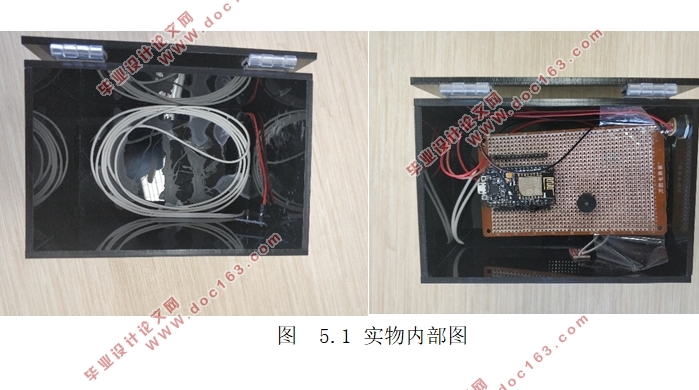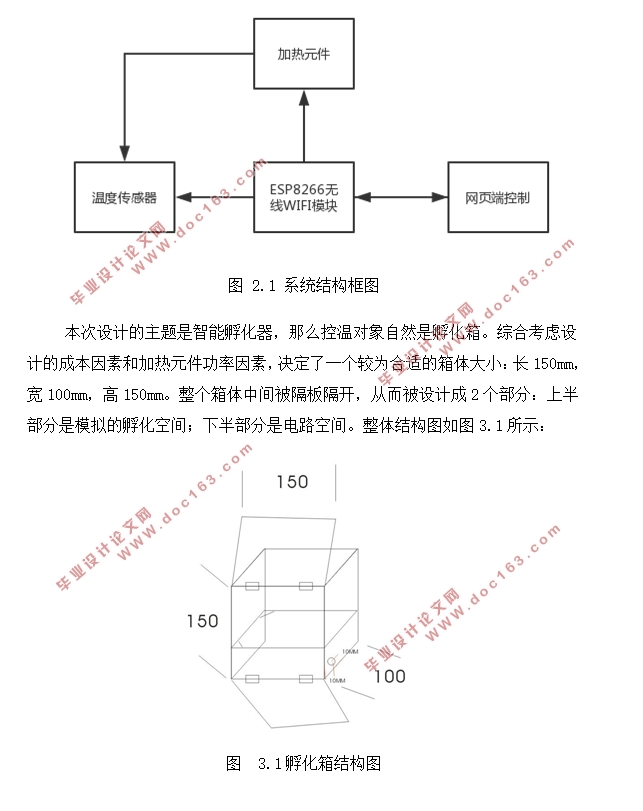基于单片机的智能孵化器设计

基于单片机的智能孵化器设计(任务书,开题报告,外文翻译,论文11000字)
摘要
随着科技日新月异的发展,人们在生活各个领域都有了技术上的革新,畜牧业也是如此。就孵化技术而言,人们已不满足于传统的由母禽来自由孵化,而是通过智能化的人工孵化系统来实现自主孵化。本次设计就是通过以单片机为核心,以网页端来控制实现孵化的智能化控制。
当前的工业生产和自动控制过程中,温度都是不可或缺的参数,基本所有的物理化学变化均存在温度的影响因素,所以在进行系统运转过程中就应该注重温度的检测与调控。单片机因为其效率较高,体积微小以及工作稳定等优点,在现今生产生活中的温度检测,数据处理和显示方面承担着重要的作用,而且其成本一般不高,广泛性也远超其他测温方法。
本文对设计背景和设计思路进行了简单的解释,介绍了系统的硬件部分和软件部分。本次设计利用ESP8266模块控制温度传感器DS18B20的进行恒温控制,并且与服务器通讯从而用网页端显示温度,从而实现智能孵化器的效果。
关键词:智能化,恒温控制,孵化器,单片机
Abstract
With the rapidly-changed development of science,innovation in technology field has taken place in various aspect of human's life such as animal husbandry field.When it comes to hatching technology,people is becoming unsatisfied to the traditional way of hatching which means eggs are hatched by hens.They resort to the intellective artificial hatching system to hatch eggs automatically instead.This design is planning to realize the intellective hatching system by using the MCU as a core and applying web site to control.
Temperature is always an indispensable parameter in current manufacturing and automation progress,and nearly all the physical or chemical reactions are affected by the temperature factor.So it is very important to check and control it when system is running.Due to the advantages of high efficiency,small volume,stable work and so on.nowadays MCU plays an important role in temperature testing,statistic processing and displaying.Furthermore,MCU has a wider range of usage than other methods because of its cheaper price.
This article gives a simple explanation of the design background and ideas,and introduce both hardware part and software part of this system.This design uses ESP8266 module to control the temperature sensor DS18B20 to maintain the temperature value and to communicate with server to display the data in the form of website,which finally achieve the Intelligent incubator.
Keywords:intellective,constant temperature control,incubator,MCU
系统整体框架
整体系统的核心是ESP8266无线WIFI模块,不仅承担单片机核心作用,还负责与网页端的通讯。加热部分由铺设在孵化箱内的电热丝实现,而由温度测量部分由同样设置在孵化箱内的DS18B20温度传感器来完成。然后采集到的温度数据被传输到ESP8266模块,然后ESP8266模块一方面烧录PID算法实现恒温控制,另一方面将数据通过传输协议与服务器通讯,将温度信息显示在网页端上。 [来源:http://www.doc163.com]
[资料来源:http://Doc163.com]


目录
摘要 I
Abstract II
第1章 绪论 1
1.1研究实现孵化器恒温控制系统的意义 1
1.2 智能孵化器的国内外发展现状 1
1.3孵化的设定和环境要求 2
1.4孵化方案和指标的确定 3
第2章 总体方案设计 4
2.1温度测量电路方案论证 4
2.2显示方案论证 4
2.3加热元件的选择 5
2.4系统整体框架 5
第3章 系统硬件介绍 7
3.1温度采集电路 7
3.1.1 DS18B20温度传感器介绍 7
3.1.2 DS18B20温度传感器特性 7
3.1.3 DS18B20温度传感器结构 8
3.1.3 DS18B20测温原理介绍 11
3.1.4接口电路 12
3.2 单片机和无线通信电路 12
3.2.1 ESP8266模块特点 12
3.2.2 ESP8266模块结构 13
3.3 孵化箱设计 15
3.3.1材料选择 16
3.3.2 结构区间介绍 16
第4章 系统软件设计 18
4.1 PID恒温控制 18
4.2 服务器和网页设计 19
4.2.1 工作原理 19
4.2.2 网页设计 20
第5章 结果与展望 21
参考文献 22
致谢 23 [来源:http://www.doc163.com]
